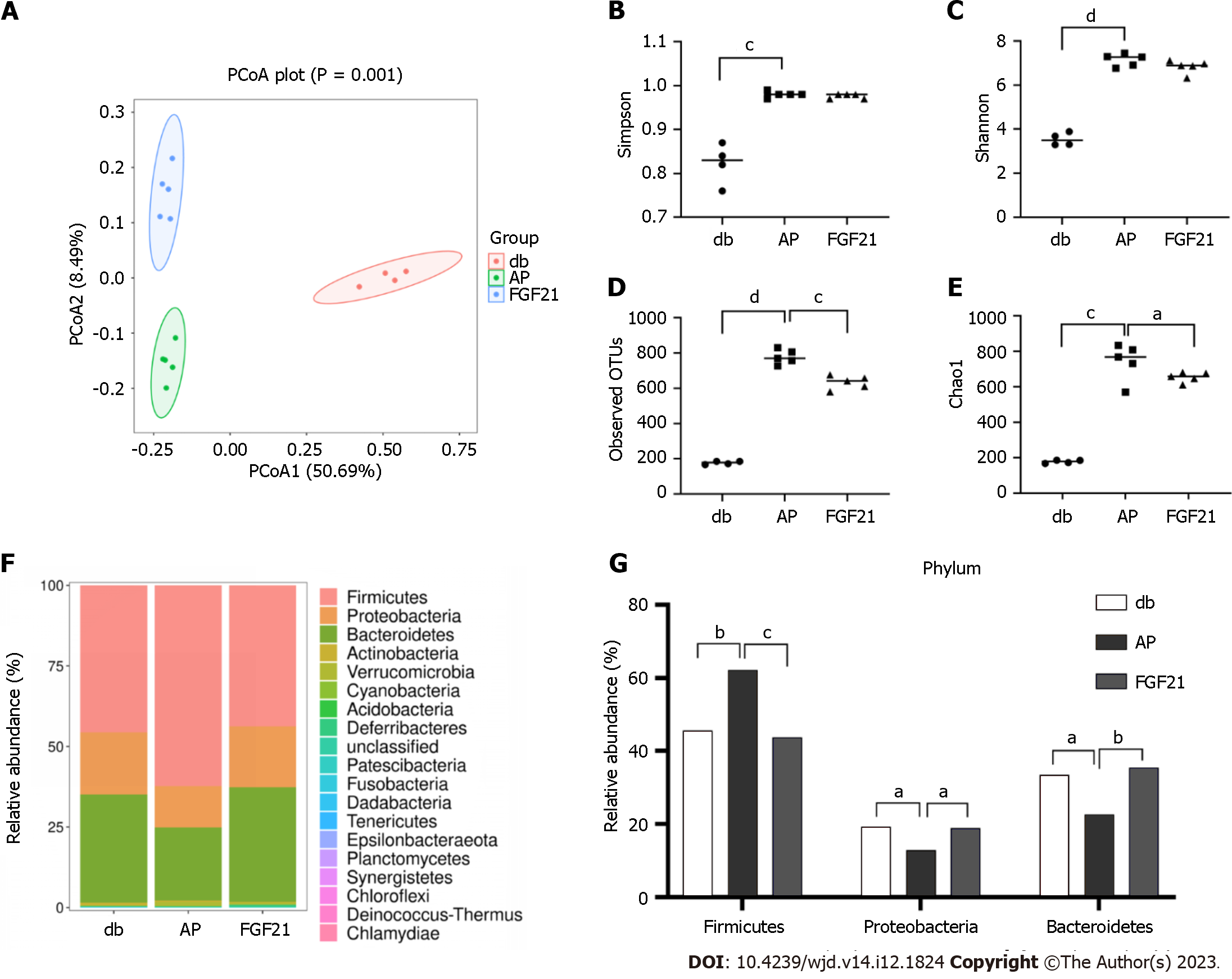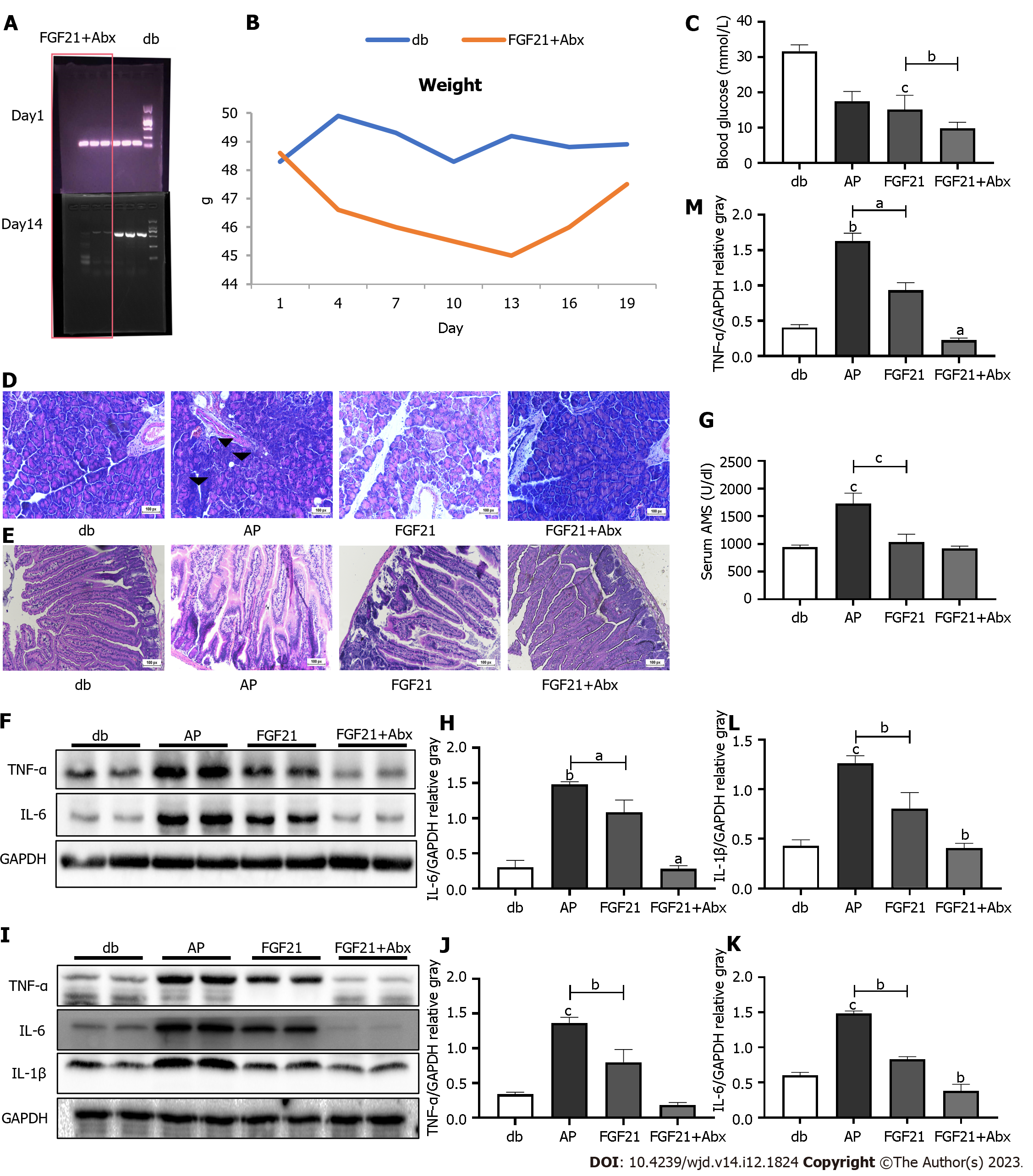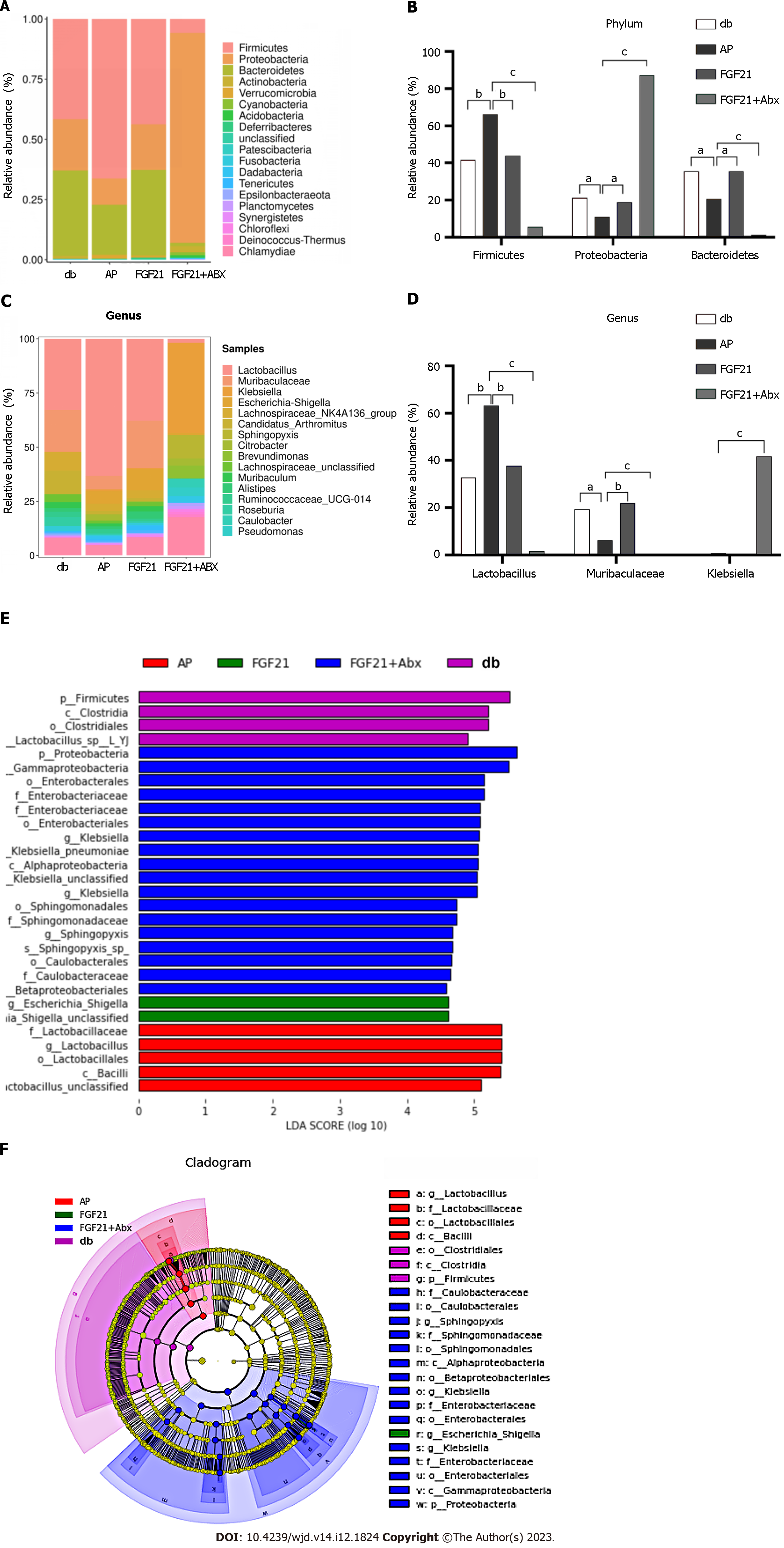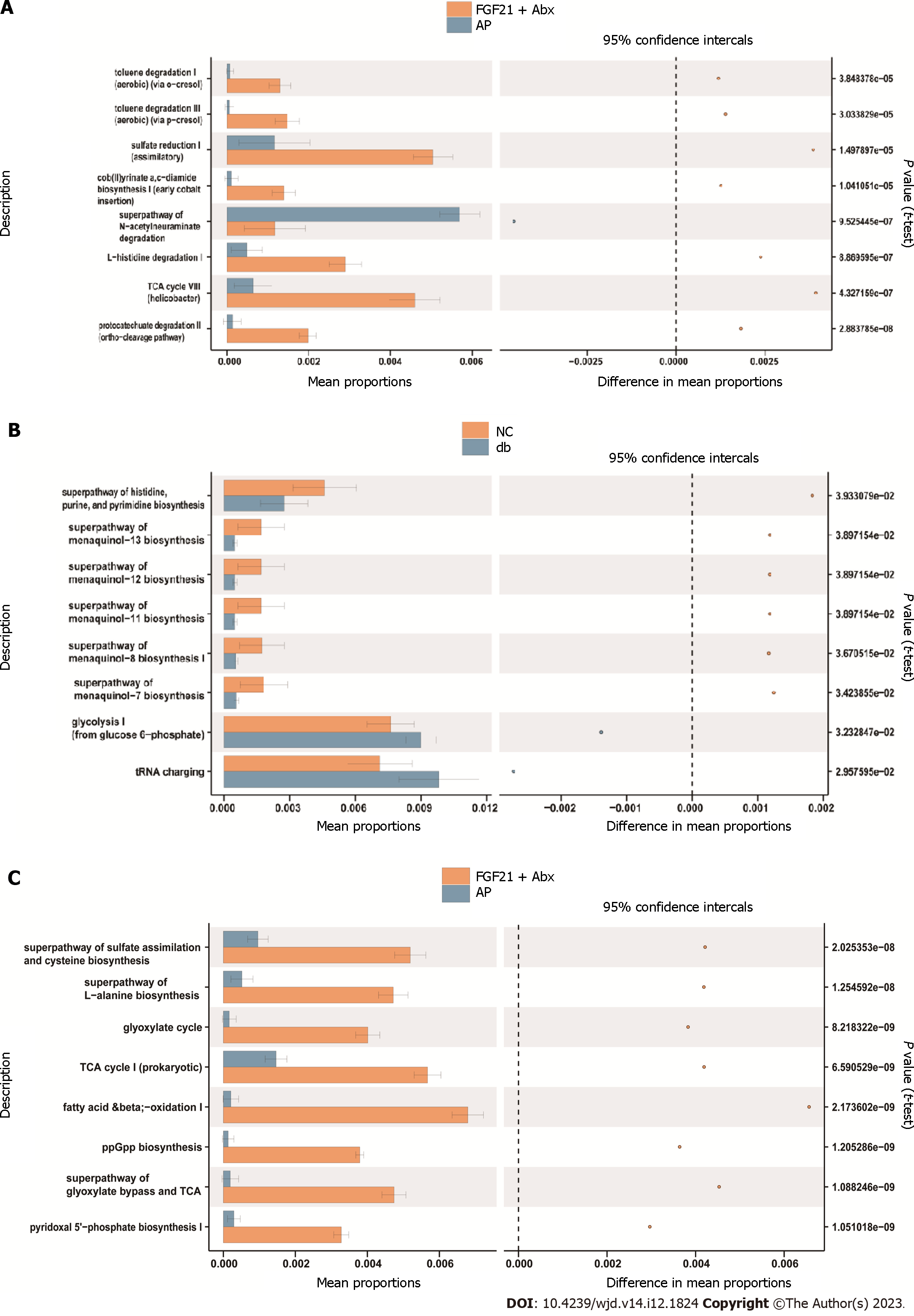Copyright
©The Author(s) 2023.
World J Diabetes. Dec 15, 2023; 14(12): 1824-1838
Published online Dec 15, 2023. doi: 10.4239/wjd.v14.i12.1824
Published online Dec 15, 2023. doi: 10.4239/wjd.v14.i12.1824
Figure 1 Fibroblast growth factor 21 significantly attenuates pancreatic injury and inflammation in diabetic mice with acute pancreatitis.
A: The ratio of pancreas weight to body weight of mice in diabetic (db), acute pancreatitis (AP) and fibroblast growth factor 21 (FGF21) groups; B: Serum levels of amylase of mice in db, AP and FGF21 groups; C-E: Representative immunoblots of inflammatory factors in mouse pancreatic tissue. Expression levels of interleukin-6 and tumor necrosis factor-alpha were quantified using densitometry, with GAPDH as a protein loading control; F: Pathological changes in pancreatic tissues of mice in db, AP and FGF21 groups, such as pancreatic edema, extensive intracellular vacuolation, and cellular necrosis (scale bar: 100 µm). Data are presented as mean ± SD, aP < 0.05, bP < 0.01, cP < 0.001. AP: Acute pancreatitis; AMS: Amylase; db: Diabetic; IL: Interleukin; TNF-: Tumor necrosis factor-alpha; FGF21: Fibroblast growth factor 21.
Figure 2 Fibroblast growth factor 21 treatment mitigates intestinal damage and inflammation in diabetic mice with acute pancreatitis.
A: Histological changes in the small intestine of mice in diabetic, acute pancreatitis and fibroblast growth factor 21 groups, characterized by tissue edema, increased villus width, and villus damage (scale bar: 100 µm); B-E: Representative immunoblots of inflammatory factors in mouse small intestinal tissue. Expression levels of interleukin-6 and tumor necrosis factor-alpha were quantified using densitometry, with GAPDH as a protein loading control. Data are presented as mean ± SD, aP < 0.05, bP < 0.01, cP < 0.001. AP: Acute pancreatitis; db: Diabetic; IL: Interleukin; TNF-: Tumor necrosis factor-alpha; FGF21: Fibroblast growth factor 21.
Figure 3 Fibroblast growth factor 21 treatment improves the composition of gut microbiota.
A: Principal coordinate analysis results demonstrated distinct segregation of the microbial communities among the diabetic (db), acute pancreatitis (AP), and fibroblast growth factor 21 (FGF21) groups. Different colors in the scatter plots represent samples from different groups; the higher the similarity between samples, the closer they are in the plots; B-E: The observed operational taxonomic units, Chao1, Shannon, and Simpson indices of the gut microbiota of db, AP and FGF21 group mice. All four indices increased in the AP group compared with the db group, and the FGF21 group exhibited decreases compared with the AP group; F: Bar graph of the structural distributions of fecal microbial communities at the phylum level; G: Relative abundance of the dominant phyla. aP < 0.05, bP < 0.01, cP < 0.001, dP < 0.0001. AP: Acute pancreatitis; db: Diabetic; IL: Interleukin; TNF-: Tumor necrosis factor-alpha; FGF21: Fibroblast growth factor 21.
Figure 4 Combined therapy of Abx cocktail and fibroblast growth factor 21 significantly decreases the susceptibility to acute pancreatitis in diabetic mice.
A: Verification of the intestinal microbiota removal after feeding antibiotics; B: Following Abx cocktail treatment initiation, the body weight change of mice; C: Serum amylase levels of mice in each group; D: Pathological changes in pancreatic tissues of mice in each group, such as pancreatic edema, extensive intracellular vacuolation, and cellular necrosis (scale bar: 100 µm); E: Histological changes in the small intestine of mice in each group, characterized by tissue edema, increased villus width, and villus damage (scale bar: 100 µm); F-H: Representative immunoblots of inflammatory factors in mouse pancreatic tissue. Expression levels of interleukin (IL)-6 and tumor necrosis factor (TNF)-alpha were quantified using densitometry, with GAPDH as a protein loading control; I-L: Representative immunoblots of inflammatory factors in mouse small intestinal tissue. Expression levels of IL-6, TNF- and IL-1 were quantified using densitometry, with GAPDH as a protein loading control. M: Changes in blood glucose in mice in different groups. Data are presented as mean ± SD, aP < 0.05, bP < 0.01, cP < 0.001. AP: Acute pancreatitis; db: Diabetic; IL: Interleukin; TNF-: Tumor necrosis factor-alpha; FGF21: Fibroblast growth factor 21.
Figure 5 Abx cocktail combined with fibroblast growth factor 21 treatment alters microbiota in diabetic mice with acute pancreatitis.
A: Bar graph of the structural distributions of fecal microbial communities at the phylum level; B: Relative abundance of the dominant phyla; C: Bar graph of the structural distributions of fecal microbial communities at the genus level; D: Relative abundance of the dominant genera; E: Linear discriminant analysis (LDA) scores for the differentially abundant bacterial taxa between each group (LDA > 4.5); F: The phylogenetic tree shows the origins of the microbiota at different taxonomic levels. aP < 0.05, bP < 0.01, cP < 0.001. AP: Acute pancreatitis; db: Diabetic; FGF21: Fibroblast growth factor 21.
Figure 6 The significantly different gene functions among groups.
A: The differential pathways between the fibroblast growth factor 21 (FGF21) + Abx group and the acute pancreatitis (AP) group; B: The differential pathways between the diabetic (db) and AP groups; C; The differential pathways between the db and FGF21 + Abx groups. AP: Acute pancreatitis; db: Diabetic; FGF21: Fibroblast growth factor 21.
- Citation: Sun QY, Wang XY, Huang ZP, Song J, Zheng ED, Gong FH, Huang XW. Depletion of gut microbiota facilitates fibroblast growth factor 21-mediated protection against acute pancreatitis in diabetic mice. World J Diabetes 2023; 14(12): 1824-1838
- URL: https://www.wjgnet.com/1948-9358/full/v14/i12/1824.htm
- DOI: https://dx.doi.org/10.4239/wjd.v14.i12.1824














